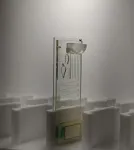(Press-News.org) A team of engineers and clinicians has developed an ultra-thin, inflatable device that can be used to treat the most severe forms of pain without the need for invasive surgery.
The device, developed by researchers at the University of Cambridge, uses a combination of soft robotic fabrication techniques, ultra-thin electronics and microfluidics.
The device is so thin - about the width of a human hair - that it can be rolled up into a tiny cylinder, inserted into a needle, and implanted into the epidural space of the spinal column, the same area where injections are administered to control pain during childbirth.
Once correctly positioned, the device is inflated with water or air so that it unrolls like a tiny air mattress, covering a large section of the spinal cord. When connected to a pulse generator, the ultra-thin electrodes start sending small electrical currents to the spinal cord, which disrupt pain signals.
Early tests of the device suggest that it could be an effective treatment for many forms of severe pain - including leg and back pain - which are not remedied by painkillers. It could also be adapted into a potential treatment for paralysis or Parkinson's disease. However, extensive tests and clinical trials will be required before the device can be used on patients.
Although other types of spinal cord stimulation devices are currently used to treat severe pain, the most effective of these devices are bulky and require invasive surgery, while current keyhole devices are far less effective at treating pain. By combining the clinical effectiveness of the surgical devices and the ease of implantation of the keyhole devices, the Cambridge-developed device could be an effective, long-term solution to intractable pain, which affects millions worldwide. The results are reported in the journal Science Advances.
Pain is something that everyone experiences, and for the vast majority of people, it is temporary and treatable. However, for some, pain becomes debilitating. In the UK, back pain is the leading cause of disability, costing the economy around £12 billion per year. In the US, the Centers for Disease Control and Prevention estimates that as many as one in 12 Americans suffer from intractable back pain, which does not respond to conventional treatments such as non-steroidal anti-inflammatory drugs (NSAIDs) or opioids.
Spinal cord stimulation (SCS) is an option for those who suffer from intractable back pain or other types of neuropathic pain, but despite its effectiveness, its use is limited, with just 50,000 procedures carried out worldwide each year.
"Spinal cord stimulation is a treatment of last resort, for those whose pain has become so severe that it prevents them from carrying out everyday activities," said Dr Damiano Barone from Cambridge's Department of Clinical Neurosciences, one of the paper's senior authors. "However, the two main types of SCS devices both have flaws, which may be one reason their use is limited, even though millions struggle with chronic pain every day."
The most effective SCS device in clinical use is a paddle-type device, which covers a wide area of the spinal cord but is bulky and requires invasive surgery under general anaesthetic. The other type of device can be implanted with a needle and only requires local anaesthetic, but it covers a smaller area and is less clinically effective than a paddle-type device.
"Our goal was to make something that's the best of both worlds - a device that's clinically effective but that doesn't require complex and risky surgery," said Dr Christopher Proctor from Cambridge's Department of Engineering, the paper's other senior author. "This could help bring this life-changing treatment option to many more people."
"In order to end up with something that can be implanted with a needle, we needed to make the device as thin as possible," said co-first author Ben Woodington, also from the Department of Engineering.
The researchers used a combination of manufacturing techniques to build their device: flexible electronics used in the semiconductor industry; tiny microfluidic channels used in drug delivery; and shape-changing materials used in soft robotics.
Their finished device is just 60 microns thick - thin enough that it can be rolled up and placed in a needle for implantation. However, after implantation, the device expands out to cover a wide area of the spinal cord, thanks to the microfluidic channels.
"Thin-film electronics aren't new, but incorporating fluid chambers is what makes our device unique - this allows it to be inflated into a paddle-type shape once it is inside the patient," said Proctor.
"Our earlier versions were actually so thin that they were invisible to x-rays, which the surgeon would need to use to confirm they're in the right place before inflating the device," said Woodington. "We added some bismuth particles to make it visible without increasing the thickness too much. Designing a device is one thing, but putting it into surgical use is quite another."
The researchers validated their device in vitro and on a human cadaver model. They are currently working with a manufacturing partner to further develop and scale up their device and are hoping to begin tests in patients within two to three years.
"The way we make the device means that we can also incorporate additional components - we could add more electrodes or make it bigger in order to cover larger areas of the spine with increased accuracy," said Barone. "This adaptability could make our SCS device a potential treatment for paralysis following spinal cord injury or stroke or movement disorders such as Parkinson's disease. An effective device that doesn't require invasive surgery could bring relief to so many people."
INFORMATION:
The technology is being commercialised by Cambridge Enterprise, the University's commercialisation arm. The research was supported in part by the Engineering and Physical Sciences Research Council, the Borysiewicz Biomedical Science Fellowship, the Medical Research Council, Health Education England and the National Institute for Health Research.
A new electrode that could free up 20% more light from organic light-emitting diodes has been developed at the University of Michigan. It could help extend the battery life of smartphones and laptops, or make next-gen televisions and displays much more energy efficient.
The approach prevents light from being trapped in the light-emitting part of an OLED, enabling OLEDs to maintain brightness while using less power. In addition, the electrode is easy to fit into existing processes for making OLED displays and light fixtures.
"With our approach, you can do it all in ...
More corn is grown in the United States than any other crop, but we only use a small part of the plant for food and fuel production; once people have harvested the kernels, the inedible leaves, stalks and cobs are left over. If this plant matter, called corn stover, could be efficiently fermented into ethanol the way corn kernels are, stover could be a large-scale, renewable source of fuel.
"Stover is produced in huge amounts, on the scale of petroleum," said Whitehead Institute Member and Massachusetts Institute of Technology (MIT) biology professor Gerald Fink. "But there are enormous technical challenges to using them cheaply to create biofuels and other important chemicals."
And so, year after year, most of the woody corn material is left in the fields to rot.
Now, a ...
DURHAM, N.C. - Biomedical engineers at Duke University have demonstrated a tablet-sized device that can reliably detect multiple COVID-19 antibodies and biomarkers simultaneously.
Initial results show the test can distinguish between antibodies produced in response to SARS-CoV-2 and four other coronaviruses with 100% accuracy.
The researchers are now working to see if the easy-to-use, energy-independent, point-of-care device can be used to predict the severity of a COVID-19 infection or a person's immunity against variants of the virus.
Having also recently shown the same "D4 assay" platform can detect Ebola infections a day earlier than the gold standard polymerase chain reaction (PCR) test, the researchers say the results show how flexible the technology can be to adapt to other ...
CAMBRIDGE, MA - Boosting production of biofuels such as ethanol could be an important step toward reducing global consumption of fossil fuels. However, ethanol production is limited in large part by its reliance on corn, which isn't grown in large enough quantities to make up a significant portion of U.S. fuel needs.
To try to expand biofuels' potential impact, a team of MIT engineers has now found a way to expand the use of a wider range of nonfood feedstocks to produce such fuels. At the moment, feedstocks such as straw and woody plants are difficult to use for biofuel production because they first need to be broken down to fermentable sugars, a process that releases numerous byproducts that are toxic to yeast, the microbes most commonly used to produce biofuels.
The ...
Tuberculosis is one of the top ten causes of death worldwide, infecting about one-quarter of the world's population. Although it is treatable, the rise of multidrug-resistant tuberculosis poses a major threat to global health security, and has been declared by the World Health Organization as a global health emergency. Reduced access to diagnosis and treatment during the COVID-19 pandemic is expected to dramatically increase the number of tuberculosis infections. This will set global efforts to tackle the disease back several years.
Tuberculosis is caused by infection with Mycobacterium tuberculosis: a bacterium that infects human lungs and other organs by using complex molecular ...
When Winter Storm Uri hit, many Texans lost power from February 14-20, resulting in losses of lives and economic activity, and damages to their homes that for some are still not completely repaired. Now, four months later as demand for electricity has increased at the start of the summer amid tight supply, Texans continue to prioritize improvements to the power grid, albeit with doubt as to whether the Texas Legislature and Governor can get the job done.
In a survey by the Hobby School of Public Affairs and UH Energy at the University of Houston fielded between May 13-24, 1,500 individuals in Texas aged 18 and older responded to a series of questions regarding their experience during Winter Storm Uri and their evaluation ...
BOSTON - At the recent 2021 Annual Scientific Sessions of the American Diabetes Association, researchers from Massachusetts General Hospital (MGH) presented positive updates on their trials of the bacillus Calmette-Guérin (BCG) vaccine to safely and significantly lower blood sugars.
In type 1 diabetes, an autoimmune disease which currently has no cure, T cells attack the pancreas and destroy its ability to create insulin, a hormone vital in allowing glucose to enter cells to produce energy. In prior work, Denise Faustman, MD, PhD, director ...
A new study by UC Davis researchers confirms the low likelihood that SARS-CoV-2 contamination on hospital surfaces is infectious. END ...
Scientists from the University of Michigan have developed an innovative way to use NASA satellite data to track the movement of tiny pieces of plastic in the ocean.
Microplastics form when plastic trash in the ocean breaks down from the sun's rays and the motion of ocean waves. These small flecks of plastic are harmful to marine organisms and ecosystems. Microplastics can be carried hundreds or thousands of miles away from the source by ocean currents, making it difficult to track and remove them. Currently, the main source of information about the location ...
New Rochelle, NY, June 24, 2021—The American Thyroid Association, the European Association of Nuclear Medicine, the European Thyroid Association, and the Society of Nuclear Medicine and Molecular Imaging released a joint statement on three key topics addressing controversies in thyroid cancer care. The joint statement is published in the peer-reviewed journal Thyroid®, the official journal of the American Thyroid Association® (ATA®).Click here to read the statement now.
An inter-societal working group addressed the current controversies and evolving concepts in three main areas: peri-operative risk stratification; the role of diagnostic radioactive iodine ...




